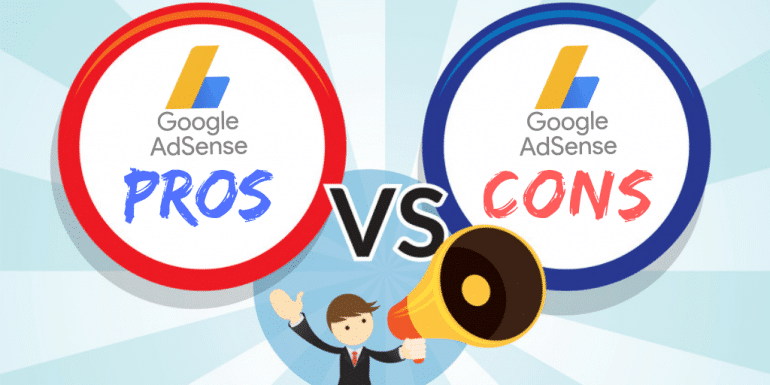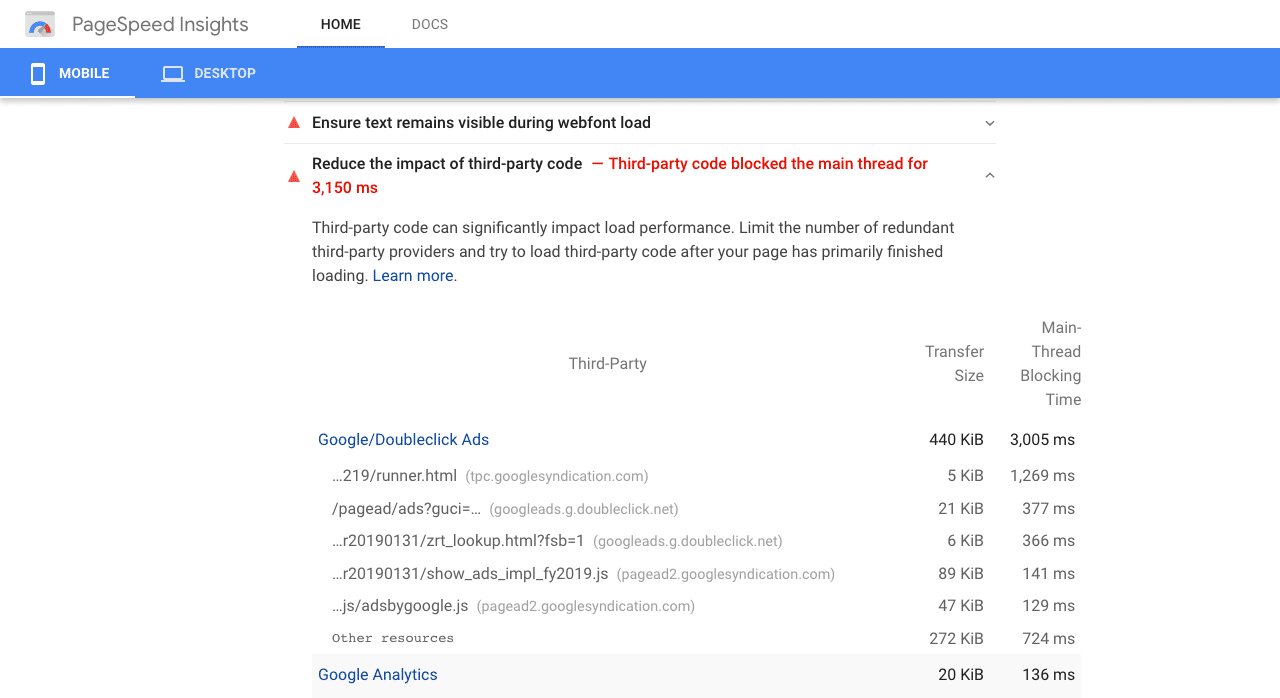Do you want to add Adsense to your blog but aren’t sure if it is the right time start monetizing? Read the pros and cons and then decide

Do you want to have an Adsense on your blog but aren’t sure if it is the right thing?
Let me help you with the pros and cons of having Adsense on your blog so you can decide if this is the right time to have it or you should wait for the right time.
However, no one answer will fit all.
One can’t say for sure that Adsense isn’t good for blogs because hundreds of thousands of blogs do have it, and they are making a good income from it.
Similarly, some webmasters are against having ads on the blog.
So without much ado, let us begin.
Pros of Having Adsense on Your Blog
Let us first start with the pros. Let me share why having Adsense on the blog can help you convert blogging into a business.
1. Easy Monetization Option to Try
The most important aspect of using Adsense on your blog is – it is super easy to start earning money from Adsense.
It is as simple as pasting one line of code in WordPress’s header, and you are all done. When I say one line of JavaScript code, it is a single line of code that one needs to add. The money can start trickling into your Adsense account.
Once the blogger starts making money, he can focus on doing the right things for the blog to prosper, generating valuable content for the audience.
The blogger doesn’t need to worry about creating products or services, find affiliate products that your audience may want, or experiment and share reviews.
Once you have good content on your blog, the process to get approval from Adsense is relatively straightforward, and once approved, one can get started in a matter of hours.
2. Works With Almost Every Niche
The best part of Adsense is, it works well with almost every niche blog one can imagine online.
However, an important point to consider is – if a niche is related to gambling content or if it contains adult content, your blog may not get approved in Adsense. By adult content, I don’t mean porn but content with some degree of nudity.
Still, barring those few niches, Adsense works well for any other blog, primarily educative blogs.
3. One Adsense Account, Multiple Blogs
You only need to get an Adsense account approved for one blog. Then you can use the same Adsense account on multiple websites and blogs provided each of the blog complies with the Adsense policies and guidelines.
However, you need to get each of your websites verified and approved in Adsense, but it is relatively simple and doesn’t take very long for the websites to get approved.
4. Ads Aren’t Intrusive
The best part of Google Adsense is, if you aren’t using Vignette Ads on mobile, the ads aren’t very intrusive.
It means your readers won’t mind seeing a few ads on the blog.
I am blogging for a long time and keep the intrusive and over flashy ads out. I am yet to see any of my blog readers complain about having Google Ads on my blog.
So I can say for sure that Adsense Ads on your blog aren’t too flashy or intrusive to your readers. Moreover, they aren’t even very annoying to the blogger either.
5. Predictable Income
Last but by no means the least benefit of using Adsense on your blog has to be the consistency of its income performance.
I agree the income from Adsense is more or less related to the traffic your blog will get, but for a blog with consistent traffic, one can easily predict the earnings based on the past eCPM.
Because one can predict the earnings with consistency, one can make a living blogging and Adsense as a source of revenue to start with. Moreover, there is a degree of growth that one can expect as the traffic grows.
Cons of Having Adsense on Your Blog
All that glitters is not gold, and there are some disadvantages when you want to use Google Adsense on your blog.
1. Lose Readers for Pennies
When you have Adsense on your blog, the Ads are related to your content. Moreover, Google Ads and Adsense are predominantly a CPC network.
CPC or Cost per click means you get paid when a visitor clicks on the ads and move over to the advertiser’s site.
Google Ads’ advertisers are smart enough to keep the per click value low for Google Adsense sites but high for Google search. So you may be driving a lot of traffic on your blog, but they can be pulled away by an advertiser paying your very little.
To share an example to help you understand, the cost per click for a keyword “buy tv sets” may be very high in Google search. However, if you have an article for “best tv sets to buy” and rank well in Google search and has Adsense, advertisers can get the traffic from your blog at a much lower cost.
So you may lose readers to advertisers for a lot less.
2. Ad Blockers are Very Common
With Google Adsense, the blogger earns money when a visitor sees the Ads and clicks on it to visit the advertiser.
With AdBlocker so common these days, the visitors don’t see the Ads at all. It means the blogger loses on the potential revenue that the Ad may have generated.
However, some Ad blocking settings are such that they show the non-intrusive ads but still blocking of Ads is very common these days. By default, some browsers have Ads blocked. On top of that, some tracking blockers also block Interest-based Google Ads.
All in all, it is a revenue killer for the blogger, and there is nothing one can do about it. All one can do is request.
Some large sites detect Adblocker and don’t show the content unless they unblock the site and view it along with the ads. However, as a new blogger, it can badly impact the site’s usability and so not recommended.
3. Earnings is directly Proportional to Traffic
Earnings with Google Adsense is directly proportional to the amount of traffic a blog generates.
So in a given niche, other factors like ad placement and other things remain the same; 100k page views per month will generate ten times more money than a blog with 10k page views per month.
In some niche, the amount can be significantly higher than other because of more and more advertisers competing for the ad view and clicks.
However, in a given niche, more traffic is a way to boost Adsense income.
Consistent earning is a benefit in Adsense, but it also can be a disadvantage because if you want to get more income, you have to get a lot more traffic.
4. Need High Traffic Blog to Make Decent Adsense Income
Typically for major niches, the Adsense eCPM can vary between $1 and $5.
Consider it a rough estimate because depending on the proportion of traffic GEO for a niche, the eCPM can vary significantly. For example, a food niche with significant traffic from India can have a lot less eCPM than a substantial US traffic blog.
Still, to make $100 per day, the blog will need thousands of page views. In some cases, it can be even 100k PVs per day.
Now consider a freelancer starting even at a low rate of $10 per hour can easily make $100 per day working for 10 to 12 hours a day.
I see it as one of the primary reasons why so many Indian writers prefer freelancing and ghostwrite instead of starting their blog.
5. AdSense Ads Impacts Page Speed
When you ad Google Adsense on any page, it slows down the page loading time by a considerable margin.

On my page, I have the Google Adsense code in the footer, and yet you can see it adds 2 seconds to the overall page loading.
As a web developer, I know it is bound to happen. Google has to pool the ads in real-time and serve them for maximum viewability and click from the visitor. Though it is by Google and is super fast, it will still need some computation before showing an ad to the visitor. Other Ad network adds a lot more time to the overall page loading.
6. Privacy and Tracking by Google
When you add Google Adsense code on your website and allow interest-based ads, you allow Google to track a lot more about your reader.
There isn’t much one can do about it. However, there is an option to disable interest-based ads. Still, it also means you will lose a considerable chunk of your revenue because then the ads will be based on the content on the page and reduce the number of advertisers bidding for a view and click.
Furthermore, the option to disable interest-based ads is for an Adsense account and not for a particular blog or website. So it means if you do not wish to have interest-based ads on your one of the site, you have to disable the feature for all the other site. Maybe Google has kept it that way because Google doesn’t want publishers to disable it.
7. Stricter Guidelines for Account Approval
The guidelines for account approval is getting stricter and stricter.
Initially, when I started in 2005ish time, one could get an Adsense account right away. Now you need the blog to be up and running for at least six months.
For a very long time, you could start adding Adsense to any new blog within the same Adsense account, but now each of the blog has to be a verified site in Adsense before one can start monetizing it.
The process is simple, but the point I am trying to make is that an Adsense account’s approval process changes with time.
Similar is the case for a YouTube channel. One could start making money reasonably quickly on YouTube. Still, now one needs 1k Subscribers and 4k Watch hours before your channel is considered for a review under the Youtube partner program for monetization.
Final Thoughts
Though the disadvantages are more in numbers, still, they aren’t significant disadvantages. Moreover, using Adsense has so many success stories.
Since its inception, I have been part of Adsense, and as an Indian, I can tell you that having a blog with decent traffic levels can help you make $1000 per month, working on weekends. It is a substantial amount of money that can help you consider blogging as a full-time career choice. You can write for yourself instead of ghostwriting for clients. At least, that is what I believe.

